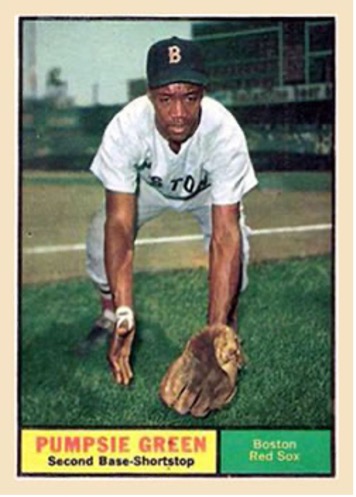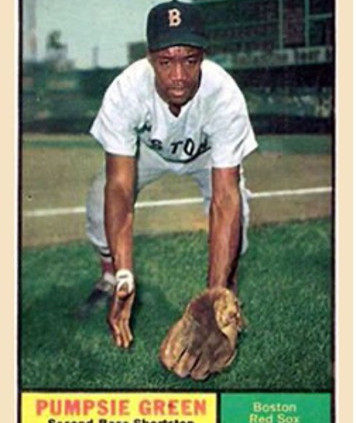July 30, 1961: Trailblazer Pumpsie Green helps Red Sox come back with pinch-hit home run
 Pumpsie Green holds two places in Boston Red Sox history – one well-known and eternal, the other obscure and perishable.
Pumpsie Green holds two places in Boston Red Sox history – one well-known and eternal, the other obscure and perishable.
The switch-hitting infielder, born Elijah Jerry Green, is remembered as the Red Sox’ first Black player, integrating the major leagues’ last segregated team on July 21, 1959. He played in 327 games in four seasons with Boston and ended his big-league career with 17 late-season appearances for the 1963 New York Mets.
Less celebrated is the fact that Green’s 23 pinch hits with the Red Sox still ranked him in the franchise’s all-time top 10 in that category as of 2024.1 Green is there by the narrowest of margins, and should the Red Sox ever employ a pinch-hit specialist, a season or two of steady work would likely knock Green off the leaderboard.2 Still, his presence on the list more than 60 years after his departure indicates that he was a useful on-field contributor as well as a trailblazer.
One of Green’s highlights in the pinch occurred in the second game of a doubleheader against the Chicago White Sox at Fenway Park on July 30, 1961. The home team dug itself into a 7-0 hole after three innings, but Green’s two-run pinch-homer in the fifth inning contributed to a slow, steady Boston comeback. The Red Sox scored in each of the game’s final seven innings, pulling out a 9-8 win in 10 frames.
The American League’s pennant race that season had shaped up into a dogfight between the New York Yankees and Detroit Tigers, with no other team within 10½ games of first place on July 30. Al López’s White Sox, two seasons removed from an AL pennant, occupied fifth place with a 50-52 record, 16½ games back. Pinky Higgins’ Red Sox had a 46-57 record3 and sat a distant sixth, 21 games out. Most of the baseball excitement in Boston at that point focused on the season’s second All-Star Game, which was played at Fenway Park the next night.4
The two sets of Sox matched up evenly in head-to-head competition that season. They played 18 games against each other, and each team won nine. The Red Sox won the first game of a scheduled four-game series, 8-3, on Friday, July 28, while the White Sox won the first game of the Sunday, July 30, doubleheader, 4-2. A scheduled game on Saturday, July 29, was rained out and made up on September 26.
Puerto Rican left-hander Juan Pizarro started the second game of the doubleheader for the White Sox. Pizarro had been acquired by Chicago on December 15, 1960, in a three-team trade that also involved the Milwaukee Braves and Cincinnati Reds.5 He entered the game with a 6-4 record and a 3.49 ERA. Pizarro opened the season in the bullpen and was moved to the rotation in mid-June; he’d pitched three times in relief against Boston without surrendering a run.
Opposing him was 6-foot-8 right-hander Gene Conley, who by happenstance had also been traded on December 15, 1960. The Red Sox sent pitcher Frank Sullivan to the Philadelphia Phillies to obtain him.
In his ninth big-league season, Conley entered with a 4-10 record and a 4.75 ERA. He’d lost his last three starts and, unbeknownst to the Red Sox, was suffering rotator-cuff pain.6 While Conley was usually a starter, his only previous appearance against the White Sox in 1961 had come in relief. He worked a shutout ninth inning in the second game of a doubleheader on May 21, stranding two runners left by starter and winner Don Schwall.7
(Conley and Green were later linked in Red Sox lore by a well-publicized incident on July 26, 1962, when they stepped off the team bus in a New York City traffic jam in search of a restroom. Left behind by the bus, the players went AWOL and undertook a drinking spree that ended with Conley unsuccessfully trying to buy a plane ticket to Jerusalem.8)
It was Connecticut Day at Fenway Park, and a contingent of Nutmeg Staters swelled the crowd to 20,996, large by 1961 standards.9 The game began with a quick White Sox run. Jim Landis led off with a walk and stole second. A pair of groundouts by rookie Floyd Robinson and Minnie Miñoso brought Landis across the plate for a 1-0 lead.10
The White Sox piled on with five more runs in the second, starting with singles by Al Smith and Nellie Fox and a run-scoring double by Luis Aparicio.11 Two outs later, Landis doubled to drive in two more runs and Robinson singled Landis home. With a 5-0 deficit, Conley was pulled for former White Sox righty Mike Fornieles, who walked Miñoso and gave up a run-scoring single to Roy Sievers before escaping the inning.
In the third inning, White Sox catcher Cam Carreón hit a two-out solo home run into the netting atop the left-field wall, his second of the season, boosting Chicago’s lead to 7-0.12 Pizarro cruised through the first three frames, yielding only a first-inning walk.
The home team collected its first hit and run in the fourth. Carroll Hardy hit an infield single and Jackie Jensen walked. Frank Malzone’s grounder forced Jensen at second and moved Hardy to third. Hardy scored when Pizarro threw a wild pitch.
More was to come in the fifth. Don Buddin drew a leadoff walk and 21-year-old rookie Carl Yastrzemski, who replaced the legendary Ted Williams in left field in 1961, flied out to center. That brought Green to the plate, batting for Fornieles. Green drilled his second home run of the season into the left-field net, making the score 7-3.13
Chuck Schilling drew a walk and Hardy’s double moved him to third. One out later, back-to-back walks to Malzone and Jim Pagliaroni handed Boston a fourth run. In the middle of the walk to Pagliaroni,14 Pizarro made way for former World Series perfect-game hero Don Larsen, who retired Vic Wertz on a grounder to first to end the rally.
Boston’s prized rookie, Yastrzemski, sparked yet another rally in the sixth inning. He hit a one-out single to center. Singles by Russ Nixon – who took Green’s spot in the lineup, entering the game at catcher – and Schilling scored him before reliever Warren Hacker closed the door. It was a 7-5 game.
“Yas”15 also decoyed the veteran Miñoso into a baserunning error in the seventh. With Miñoso on first and one out, Sievers lined a ball to left field. Yastrzemski acted as if it would bounce off the wall, and Miñoso took off. But the ball was catchable, and Yastrzemski caught it and threw to first for an easy inning-ending out.16 (Adding insult to injury, Miñoso also had $310 in cash and a diamond-studded medal stolen from his Boston hotel room during the road trip.17)
Hacker was yanked after surrendering a leadoff double to Malzone in the seventh. The Red Sox scraped together another run off Billy Pierce on a fielder’s choice, a single by Wertz, and a groundout by Buddin. 7-6, Chicago.
The White Sox offense stirred in the eighth against rookie reliever Tracy Stallard.18 Smith doubled to left field, Fox bunted him to third, and Aparicio scored him with a fly to center field for an 8-6 lead. But the Red Sox fought back in the bottom half. Nixon led off with a single, Schilling’s grounder moved him to second, and Hardy’s single off the fifth Chicago pitcher, Turk Lown, made it 8-7.
Boston first baseman Wertz, 36 years old and nearing the end of a 17-season major-league career, finally brought the Red Sox even with a 400-foot leadoff ninth-inning homer, his 11th and last of the season.19 Lown set down the next three batters and the 8-8 game moved into extra innings.
Chet Nichols, a Rhode Islander pitching on Connecticut Day, gave up a walk and a single in the top of the 10th, but no runs. It was his first appearance since June 23.20
Lown retired the first two batters in the bottom half before Jensen singled to left. Jensen stole second, and Malzone was intentionally walked to bring up the pitcher’s spot. Catcher Joe Ginsberg, who’d been released by the White Sox in May, ran in from the bullpen to hit for Nichols.21 Ginsberg played in only 19 games for Boston,22 but he came up big in this spot, hitting Lown’s first pitch off the mound and into center field to score Jensen and win the game, 9-8.23
“The Red Sox, inch by inch, fought their way back. Pumpsie Green gave them a start with a two-run pinch-homer,” the Boston Globe summarized.24 Nichols earned the win, while Lown took the loss.
Green led the Red Sox in pinch-hit at-bats in 1961 and 1962, though Nixon finished with the most pinch-hits in both seasons.25 In 1962, Green’s final season in Boston, he made 40 of his 56 appearances as a pinch-hitter. His brief stint with the 1963 Mets included one final pinch-hit opportunity on September 4, and Green delivered again, drawing a walk to prolong a four-run, seventh-inning rally in which the Mets tied a game against the St. Louis Cardinals.26
Acknowledgments
This article was fact-checked by Harrison Golden and copy-edited by Len Levin.
Sources and photo credit
In addition to the specific sources cited in the Notes, the author used the Baseball-Reference.com and Retrosheet.org websites for general player, team, and season data and the box scores for this game.
https://www.baseball-reference.com/boxes/BOS/BOS196107302.shtml
https://www.retrosheet.org/boxesetc/1961/B07302BOS1961.htm
Image of 1961 Topps card #454 downloaded from the Trading Card Database.
Notes
1 2024 Boston Red Sox media guide, 253, accessed January 2025, https://archive.org/details/2024-boston-red-sox-media-guide/page/252/mode/2up?view=theater. Specifically, Green was tied with Lou Finney and Rich Gedman for the 10th spot. The all-time franchise leader as of 2024 was Dalton Jones, with 55 pinch hits. (Hall of Famer Ted Williams ranked fourth, with 33.)
2 The single-season pinch-hit record holders in both major leagues collected more pinch hits in one season than Green did in his Red Sox career. As of 2024, the National League record was held by John Vander Wal of the 1995 Colorado Rockies, who collected 28 pinch-hits, while the American League record belonged to Dave Philley of the 1961 Baltimore Orioles, who collected 24. Baseball Almanac, “Pinch Hitting Records,” accessed August 2024, https://www.baseball-almanac.com/recbooks/pinch-hitters-records.shtml.
3 And one tie.
4 From 1959 through 1962, two All-Star Games were played per season. The second All-Star Game of 1961 was plagued by rain and was called as a 1-1 tie after nine innings.
5 On December 15, 1960, the Braves swapped Pizarro and Joey Jay to the Cincinnati Reds for Roy McMillan. The Reds then traded Pizarro and Cal McLish to the White Sox for Gene Freese.
6 John R. Husman, “Gene Conley,” SABR Biography Project, accessed August 2024, https://sabr.org/bioproj/person/Gene-Conley/.
7 Saves did not become an official major-league statistic until 1969, but Conley was retroactively awarded a save for his work in this game. It was one of 10 saves Conley was awarded in an 11-year big-league career.
8 Husman, “Gene Conley.”
9 “Keating,” “R-Sox Have Won Only One of 15 Twin Bills,” Holyoke (Massachusetts) Transcript-Telegram, July 31, 1961: 16. The 1961 Red Sox averaged 10,373 fans per home game, ranking them sixth in the 10-team AL, according to Baseball-Reference.
10 Miñoso was one of four future Hall of Famers appearing in the game. The others were Nellie Fox, Luis Aparicio, and Carl Yastrzemski.
11 Aparicio was also a future Red Sox: He spent his final three major-league seasons (1971-1973) with the team, making the All-Star team in the first two of those seasons and getting mild support for the Most Valuable Player Award in 1972.
12 Edward Prell, “Sox Win, 4-2; Then Lose, 9-8,” Chicago Tribune, July 31, 1961: 4:1.
13 Roger Birtwell, “Sox Surge, Split,” Boston Globe, July 31, 1961: 13.
14 Birtwell reported that the count was 2-and-0 on Pagliaroni when Larsen entered the game.
15 Yastrzemski’s familiar nickname of “Yaz” had not yet been firmly settled on, and newspapers used a variety of abbreviations in his early seasons, including “Yas,” “Yastro,” and “Y’ski.” Samuel Pompei, “All-Stars Won’t Beat Yastrzemski’s Fine Play,” Springfield (Massachusetts) Daily News, July 31, 1961: 20; Associated Press, “Errors Ruin Sox’ Debut as A’s Triumph, 5 to 2,” Lynn (Massachusetts) Daily Evening Item, April 12, 1961: 18; Associated Press, “Y’ski Top Bosox Ace,” Bangor (Maine) Daily News, March 15, 1960: 13.
16 Birtwell.
17 Prell, “Sox Win, 4-2; Then Lose, 9-8.”
18 Stallard earned trivia infamy at the end of the 1961 season by giving up Roger Maris’s record-setting 61st home run. Stallard and Green were also teammates on the Mets in September 1963.
19 Birtwell, “Sox Surge, Split.” Wertz played two more seasons with Detroit and Minnesota, hitting eight more homers to bring his lifetime total to 266.
20 Nichols’ SABR biography said he suffered a broken hand in late June; it was rumored to have been broken in a fight with Stallard, but both pitchers denied it. Bill Nowlin, “Chet Nichols,” SABR Biography Project, accessed August 2024. Incidentally, none of the players, managers, coaches, or umpires involved in the Connecticut Day game were Connecticut natives. (This is based on the umpires’ individual Retrosheet pages and on Baseball-Reference’s list of Connecticut natives, accessed August 2024, https://www.baseball-reference.com/bio/CT_born.shtml.)
21 Associated Press, “Bosox Win Nightcap in 10th to Gain Split,” Springfield (Massachusetts) Union, July 31, 1961: 14.
22 The veteran catcher was released by the Red Sox in October 1961.
23 Birtwell, “Sox Surge, Split.”
24 Birtwell.
25 Nixon is third on the Red Sox all-time pinch-hit list with 42.
26 After tying the game in the top of the seventh, the Mets allowed a run in the bottom half and lost 6-5.
Additional Stats
Boston Red Sox 8
Chicago White Sox 7
10 innings
Game 2, DH
Fenway Park
Boston, MA
Box Score + PBP:
Corrections? Additions?
If you can help us improve this game story, contact us.


